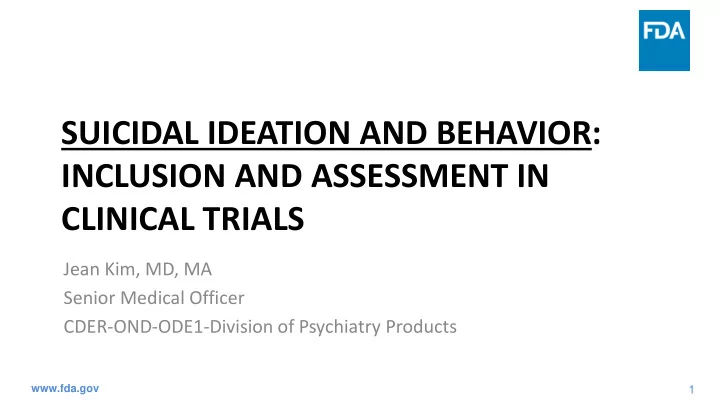

SUICIDAL IDEATION AND BEHAVIOR: INCLUSION AND ASSESSMENT IN CLINICAL TRIALS Jean Kim, MD, MA Senior Medical Officer CDER-OND-ODE1-Division of Psychiatry Products www.fda.gov 1
How is “suicidal” defined? Are there minimum and maximum thresholds or cut-offs? We recommend using the definitions of suicidal ideation and behavior found in the Columbia Classification Algorithm of Suicide Assessment: • Suicidal Ideation (SI) • Suicidal Behavior (SB) – Passive (1) – Preparatory actions towards imminent suicidal behaviors (1) – Active: Nonspecific (no method, intent, or plan) (2) – Aborted Attempt (2) – Active: Method but no intent or – Interrupted Attempt (3) plan (3) – Suicide Attempt (4) – Active: Method and intent but no – Completed Suicide (5) plan (4) • Self-injurious behavior (IB) – Active: Method, intent, and plan – No suicidal intent (6) (5) www.fda.gov 2
What degree of SI/B is appropriate for inclusion in a general MDD trial versus a study specifically targeting SI/B or prevention of suicide? • We recommend not summarily excluding patients with any SI/B from psychiatric trials • General trials: consider exclusion of those with imminent suicidal risk (i.e., C-SSRS: SI 4 to 5 or any SB) requiring acute intervention • Recent past SB or serious SI: no set time period policy, investigator discretion on safety (case by case) www.fda.gov 3
How should a trial be structured to support the inclusion of such subjects? Should safety planning and/or inpatient treatment be required? • SI/B endpoint trials: we strongly recommend standard-of-care intervention within study design (i.e., inpatient settings if clinically warranted, active controls/treatment, etc.) • Ethics and safety are paramount when including subjects with SI/B: clinical care is not the same thing as research www.fda.gov 4
What is an adequate plan to manage suicidal behavior? • Determined by clinician judgment • Study programs should incorporate independent clinical assessment and appropriate clinical triage and treatment for patients with SB www.fda.gov 5
Given that evidence for predictors of suicide is poor, on what basis would there be restrictions for inclusion? • Again, imminent suicidal risk is main exclusion factor for general trials (non-SI/B endpoint) depending on ability to include standard-of-care measures for these patients • If appropriate clinical assessment, triage, and referral to standard-of-care treatment are ensured, restrictions may be unnecessary www.fda.gov 6
In studies targeting SI/B, what efficacy endpoints should be used? Occurrence of Ideation and Behaviors versus scores? • Should code to C-CASA criteria • For now, primary underlying psychiatric illness should still be measured as primary efficacy endpoint with appropriate scale • SI/B should be measured as secondary endpoint (flexible for now on endpoint used) • Important to assess relationship between underlying condition and SI/B in any given study • Ballard et al (2015) noted rapid SI/B change may be easier to detect on less granular outcome measures (efficacy vs. safety as goal) Multidiagnostic SI/B endpoints may be considered in future • Ballard ED et al, J Psychiatr Res Sep 2015; 68:68-73. www.fda.gov 7
In studies targeting SIB, what should the comparator treatment be (are placebo-controlled trials ethical and what evidence is there that treatment-as-usual is effective?) • Placebo control may not be adequate/ethical without standard-of- care measures being included in study design for someone with imminent SI/B if condition may require medication: active treatment option should be incorporated – Consider superiority trials comparing new drug to active control, or comparing to placebo with standard of care as background therapy – Consider time to rescue designs with standard of care triage as outcome measure Evidence for standard-of-care interventions for SI/B: history of • psychiatric research and care—treating underlying illnesses may improve SI/B and care must be individualized www.fda.gov 8
In studies targeting SI/B, when is SI/B considered an adverse event (AE)? • Impractical and less informative to report every SI/B event as an AE in SI/B endpoint study • Recommend any change in baseline SI/B severity level (per C-CASA coding) to be reported as AE in these studies, and as serious AE if clinically warranted (prolonged hospitalization, change in clinical management, study discontinuation, significant clinical worsening, etc.) • For general (non-SI/B endpoint) trials: recommend C-SSRS SI 4 or 5 and/or any SB be reported as an AE, with usual SAE criteria (hospitalization, etc.) www.fda.gov 9
www.fda.gov 11
www.fda.gov 12
Recommend
More recommend